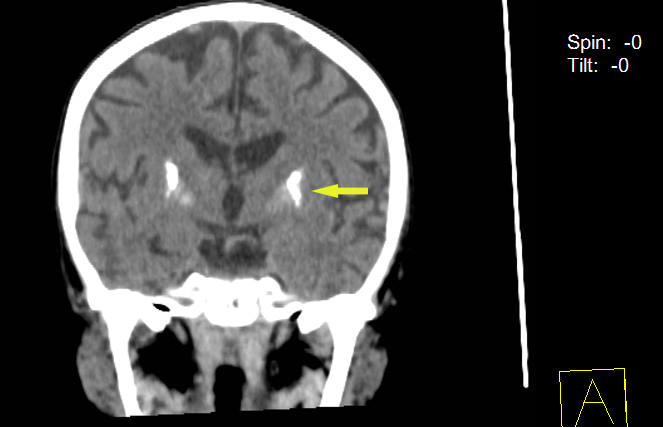Fahr syndrome in a pediatric patient. Case report
DOI:
https://doi.org/10.18537/RFCM.38.03.09Keywords:
calcinosis, basal ganglia, nervous system diseases, adolescent, TACAbstract
Introduction: Fahr syndrome is an idiopathic cerebrovascular ferrocalcinosis, which causes abnormal calcified deposits in bilateral basal ganglia, dentate nuclei, cerebellum and cerebral white matter; it is associated with neuropsychiatric symptoms. It is more common in adulthood; however it can occur less frequently in childhood. This article presents a case of progressive encephalopathy that began in childhood.
Clinical case: a 13-year-old male patient, with recurrent status epileptic episodes, abnormal gait movements and cognitive deficit of several years of evolution. Diffuse cortical atrophy, coarse and symmetrical calcifications of the base nuclei: head of the caudate nucleus, globus palidus, and tenuous calcifications in the cerebellar hemispheres. Images are compatible with Fahr syndrome.
Conclusions: Fahr syndrome can be a cause of seizures and should be considered in the clinical evaluation of a patient with seizures, especially in children and adolescents
Downloads

Published
Issue
Section
License
Copyright (c) 2021 Martina de Jesús Aguilar Pesantez, Guadalupe Priscila Cabrera Contreras, Victor Francisco Ochoa Arevalo

This work is licensed under a Creative Commons Attribution-NonCommercial-ShareAlike 4.0 International License.
Copyright © Autors.

You are free to:
 |
Share — copy and redistribute the material in any medium or format |
 |
Adapt — remix, transform, and build upon the material for any purpose, even commercially. |
Under the following conditions:
 |
Attribution — You must give appropriate credit, provide a link to the licence, and indicate if changes were made. You may do so in any reasonable manner, but not in any way that suggests the licenser endorses you or your use. |
| NonCommercial — You may not use the material for commercial purposes. | |
| ShareAlike — If you remix, transform, or build upon the material, you must distribute your contributions under the same license as the original. |
| No additional restrictions — You may not apply legal terms or technological measures that legally restrict others from doing anything the licence permits. |





